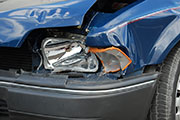
THURSDAY, March 19, 2015 (HealthDay News) — In-car breathalyzers automatically prevent ignition when they detect blood-alcohol levels that exceed legal limits. Now, new research suggests that if the devices were installed in every new U.S. car, deaths linked to drunk driving would plummet by 85 percent over a 15-year period.
Installation of the “interlock” devices would also eliminate between 84 to 88 percent of nonfatal drunk driving accidents, the analysis determined.
“This amounts to an estimated 59,000 lives saves and more than 1.25 million serious injuries prevented,” said study lead author Dr. Patrick Carter, an assistant professor with the University of Michigan Injury Center in Ann Arbor.
The study was funded by the U.S. National Institute on Alcohol Abuse and Alcoholism, and published March 19 in the American Journal of Public Health.
According to the researchers, over the last two decades more than 30 percent of all traffic fatalities have involved at least one drunk driver. And besides the tragedies of lives lost, drunk driving incurs a societal cost estimated at nearly $60 billion per year. That figure accounts for a fifth of the total annual cost attributed to motor vehicle accidents as a whole, the researchers said.
Carter’s group noted that interlock devices are already in use in every state in the nation — mainly as a judicial tool for the sentencing of those convicted of a DUI.
How do the devices work? Current models require that the driver actively breathe into a sensor connected directly to the car’s engine. However, more advanced models are now under development that would, for example, passively sample a driver’s breath and/or gauge alcohol levels automatically when his or her skin makes contact with the steering wheel.
In the new study, the Michigan team used information from two U.S. databases on traffic accidents and deaths collected by the federal government and a network of police jurisdictions nationwide.
Crunching the numbers, Carter’s team projected that adding the safety device to all new cars would save nearly 60,000 lives and prevent nonfatal injuries for 1.25 million drivers and passengers over the course of 15 years.
The biggest drop in injuries would be seen among drivers between the ages of 21 and 29. Drivers who are too young to legally drink — namely those between 16 and 21 — would be the second biggest beneficiaries should interlock devices become standard, the study found.
The researchers also predicted a significant financial benefit. They estimate that over 15 years, the United States would save nearly $343 billion in injury-related medical and legal expenses, as well as in lost wages and productivity.
That would more than compensate for the expense of rigging out new cars with the devices, Carter’s team said.
Jonathan Adkins is executive director of the Governors Highway Safety Association (GHSA). He agreed that “ignition interlocks are a critical tool in keeping impaired drivers off the roadways.”
His group “strongly supports their required use for anyone convicted of a DUI,” Adkins said, “including first-time offenders.”
But he said the technology is not yet ready for standard inclusion in all cars.
“GHSA does not support including ignition interlocks in all U.S. vehicles at this time,” Adkins said. “For any alcohol-impairment detection technology to come standard in all vehicles, it would need to be completely seamless to the driver, proven to be tamperproof, and have demonstrated strong public support.”
He believes public support is key, because of privacy issues this type of device may raise in the eyes of some.
“The public will accept interlocks for offenders,” Adkins said, “but not necessarily for all vehicles. Installing the devices in all vehicles would be seen by many as government intrusion and overstepping. For now, we want to keep the focus on offenders.”
More information
For more information on drinking and driving, head to NCADD.
Copyright © 2026 HealthDay. All rights reserved.

